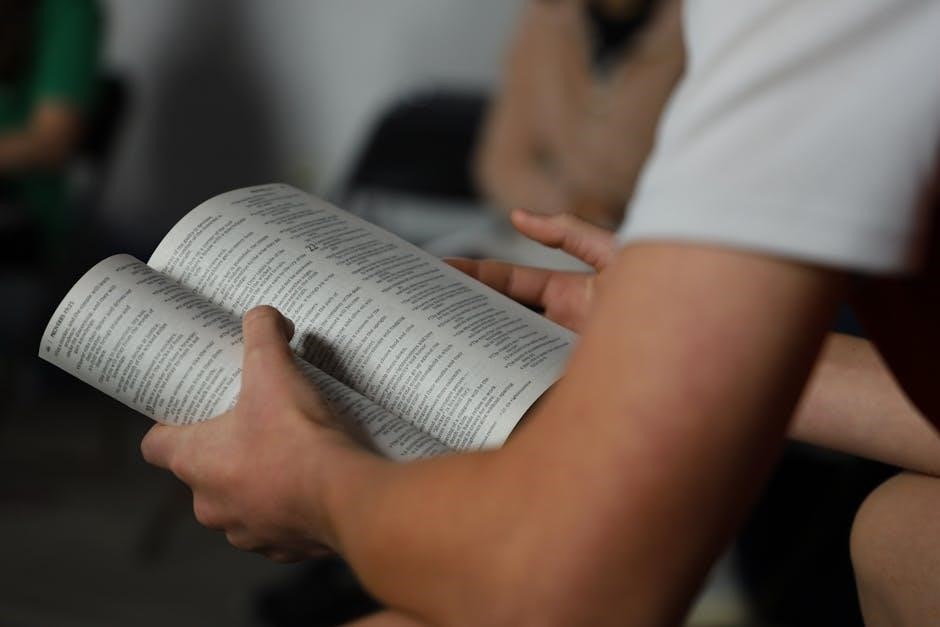
6-2 study guide and intervention parallelograms
A parallelogram is a quadrilateral with opposite sides parallel‚ offering insights into geometric properties and real-world applications. This guide supports learning through interactive activities and practical examples.
1.1 Definition and Basic Properties
A parallelogram is a quadrilateral with both pairs of opposite sides parallel. Key properties include equal opposite sides and angles‚ with consecutive angles supplementary. Understanding these foundational aspects is vital for solving geometric problems and applying concepts to real-world scenarios.
1.2 Importance of Parallelograms in Geometry
Parallelograms are fundamental in geometry due to their unique properties and versatility in solving problems. They serve as building blocks for understanding more complex shapes and theorems. The properties of parallelograms‚ such as opposite sides being equal and parallel‚ and opposite angles being equal‚ are essential in various proofs and calculations. Additionally‚ they are crucial in coordinate geometry‚ transformations‚ and real-world applications like architecture and engineering. Mastering parallelograms enhances problem-solving skills and provides a strong foundation for advanced geometric concepts.

Properties of Parallelograms
Parallelograms have opposite sides equal and parallel‚ with opposite angles equal. Consecutive angles sum to 180°‚ and diagonals bisect each other‚ forming congruent triangles.
2.1 Opposite Sides and Angles
In a parallelogram‚ opposite sides are equal in length and parallel‚ while opposite angles are equal. This symmetry is fundamental to the properties of parallelograms‚ aiding in calculations and proofs. The equal sides and angles simplify solving geometric problems‚ making parallelograms a key concept in geometry studies. These properties are essential for understanding more complex shapes and their behaviors in various mathematical contexts‚ as they provide a foundational structure for further geometric exploration and application.
2.2 Diagonals and Their Characteristics
In a parallelogram‚ diagonals bisect each other but are not necessarily equal unless the shape is a rectangle. This property is crucial for solving geometric problems and understanding the relationship between sides and angles. The diagonals divide the parallelogram into two congruent triangles‚ aiding in calculations involving area and trigonometry. Additionally‚ the characteristics of diagonals help distinguish between different types of parallelograms‚ such as rhombuses and rectangles‚ which have unique diagonal properties. These features make diagonals a vital tool in analyzing and applying parallelogram properties in various mathematical and real-world scenarios.

Sides and Angles of Parallelograms
Opposite sides of a parallelogram are equal and parallel‚ while consecutive angles are supplementary‚ adding up to 180 degrees. This relationship simplifies calculations and real-world applications.
3.1 Calculating Side Lengths
Calculating side lengths in parallelograms involves using the distance formula on the coordinate plane. By identifying coordinates of vertices‚ you can apply the formula: distance = √[(x₂ ⏤ x₁)² + (y₂ ⏤ y₁)²]. This method ensures accuracy. Additionally‚ properties like opposite sides being equal simplify calculations. If one side is known‚ its parallel counterpart is the same length. Understanding these techniques aids in solving problems efficiently‚ leveraging both geometric properties and coordinate geometry tools. This approach is especially useful for students needing intervention‚ as it provides a clear‚ step-by-step process for determining side lengths in various scenarios.

3.2 Understanding Angle Relationships
In parallelograms‚ opposite angles are equal‚ and consecutive angles are supplementary‚ adding up to 180°. This is because parallel lines cut by a transversal create corresponding angles. Using these properties‚ students can determine unknown angles by identifying known ones. For example‚ if one angle is 60°‚ its opposite is also 60°‚ and the adjacent angles are 120° each. These relationships are fundamental for solving problems and can be visualized using geometric diagrams or real-world examples like rhombuses or rectangles. Intervention strategies often emphasize these patterns to help students grasp spatial reasoning and angle relationships effectively.

Using Coordinate Geometry
Coordinate geometry uses distance‚ slope‚ and midpoint formulas to identify and analyze parallelograms‚ aiding in verifying properties and enhancing problem-solving skills in students.
4.1 Distance‚ Slope‚ and Midpoint Formulas
The distance formula calculates the length between two points‚ while the slope formula determines the steepness of lines‚ helping to identify parallel sides. The midpoint formula finds the midpoint of diagonals‚ verifying if they bisect each other. Together‚ these tools enable students to analyze and confirm parallelogram properties on the coordinate plane; By applying these formulas‚ learners can systematically test if a quadrilateral meets the criteria for being a parallelogram‚ enhancing their understanding of geometric relationships and problem-solving skills in coordinate geometry.
4.2 Testing for Parallelograms on the Coordinate Plane
To determine if a quadrilateral is a parallelogram‚ use the coordinate plane to verify key properties. First‚ plot the vertices and calculate the slopes of opposite sides using the slope formula. If the slopes are equal‚ the sides are parallel. Next‚ use the distance formula to check if opposite sides are equal in length. Finally‚ apply the midpoint formula to ensure the diagonals bisect each other. By systematically applying these steps‚ students can accurately identify and confirm parallelograms‚ reinforcing their understanding of geometric properties and relationships.

Intervention Strategies for Learning Parallelograms
Interactive activities‚ such as using geometric tools and real-world examples‚ help students grasp parallelogram concepts. Tailored support ensures all learners master properties and applications effectively.
5.1 Interactive Activities for Struggling Students
Engage students with hands-on activities like identifying parallelograms in real-life objects and using geometric tools to explore properties. Incorporate games‚ such as “Parallelogram Bingo” or “Shape Sorting‚” to make learning interactive. Utilize technology‚ like interactive whiteboards‚ to visualize concepts dynamically. Provide step-by-step guides and peer-assisted learning to build confidence. Offer manipulatives‚ such as puzzle pieces‚ to help students understand side and angle relationships. Encourage problem-solving through practical scenarios‚ such as calculating distances on a coordinate plane. These strategies cater to diverse learning styles‚ ensuring all students grasp key parallelogram concepts effectively.
5.2 Real-World Applications of Parallelograms
Parallelograms are essential in various real-world contexts. In technology‚ they are used in printer mechanisms to align paper accurately. In computer graphics‚ they aid in transforming and projecting images. Road signs often incorporate parallelogram shapes for visibility. Bridges utilize parallelogram structures for stability. Sports equipment‚ like cricket bats‚ relies on parallelogram shapes for balance. Packaging designs use parallelograms for efficient space utilization. Understanding parallelograms helps in solving practical problems‚ making geometry relevant and applicable in everyday life and professional fields. These examples highlight the importance of mastering parallelogram properties for real-world applications.

Common Core State Standards Alignment
The study guide aligns with 6th-grade geometry standards‚ emphasizing properties of parallelograms and their real-world applications‚ ensuring all students‚ including struggling learners‚ achieve core geometric understanding.
6.1 Geometry Standards for 6th Grade
The 6th-grade geometry standards focus on understanding the properties of parallelograms‚ including opposite sides and angles‚ and using coordinate geometry to analyze shapes. Students learn to identify and apply these concepts to solve real-world problems‚ aligning with the Common Core’s emphasis on critical thinking and practical application. The study guide provides targeted interventions to ensure all learners‚ including those needing extra support‚ master these foundational geometric principles. By focusing on both theoretical understanding and hands-on practice‚ the guide helps students build a strong base for advanced geometry topics.
6.2 Supporting Every Student’s Learning
This section emphasizes inclusive strategies to ensure all students grasp parallelogram concepts. By incorporating differentiated instruction‚ formative feedback‚ and technology‚ teachers can address diverse learning needs. The guide offers tailored interventions‚ such as interactive activities and real-world applications‚ to engage students and reinforce understanding. These approaches align with Common Core standards‚ promoting equity and ensuring every student‚ including English learners and those with special needs‚ can succeed. Regular assessments and personalized support help identify gaps and provide targeted assistance‚ fostering a growth mindset and preparing students for future challenges in geometry.
This study guide provides a comprehensive understanding of parallelograms‚ emphasizing their properties‚ real-world applications‚ and supportive learning strategies to ensure all students achieve geometric proficiency and confidence.
7.1 Summary of Key Concepts
A parallelogram is a quadrilateral with opposite sides equal and parallel‚ and opposite angles equal. Key properties include diagonals bisecting each other and consecutive angles supplementing to 180 degrees. Understanding these concepts is fundamental for solving geometric problems and applying them in real-world scenarios. This guide emphasized using coordinate geometry‚ distance formulas‚ and slope calculations to identify and analyze parallelograms. Intervention strategies‚ such as interactive activities and practical examples‚ were highlighted to support struggling students. Mastering these concepts aligns with Common Core standards‚ ensuring a strong foundation in geometry for all learners.
7.2 Resources for Further Study
For deeper understanding‚ explore online resources like Khan Academy and GeoGebra‚ which offer interactive tools and tutorials. Textbooks such as the Glencoe-McGraw Hill Geometry Workbook provide worked examples. Utilize library databases with keyword searches like “parallelogram properties” or “coordinate geometry.” The UCSMP-EL archives and Edexcel 1MA1 study guides are excellent for targeted practice. Additionally‚ educational websites like Math Open Reference and IXL offer visual aids and exercises. These resources cater to diverse learning styles‚ ensuring comprehensive mastery of parallelogram concepts and their applications.